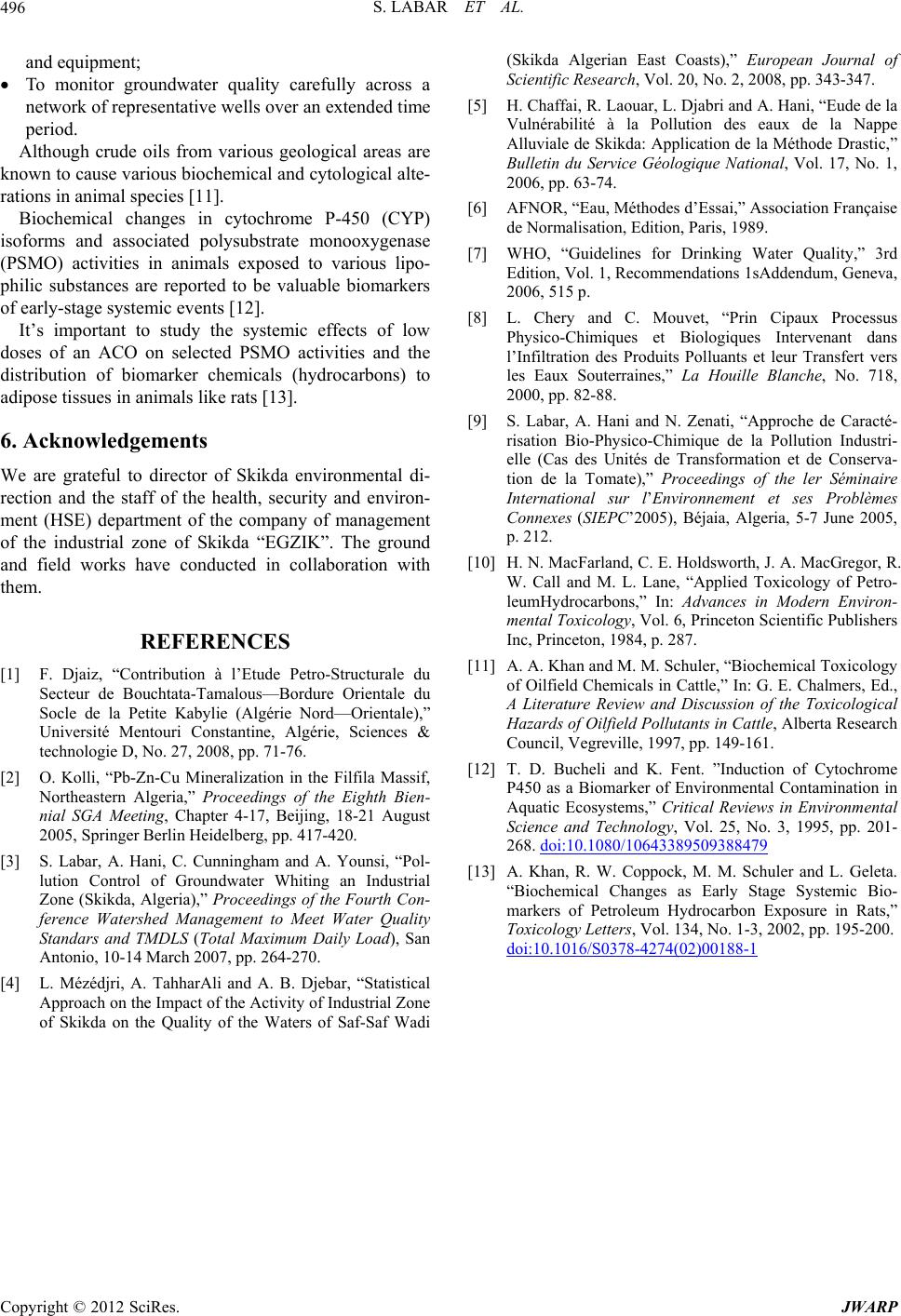
S. LABAR ET AL.
496
and equipment;
To monitor groundwater quality carefully across a
network of representative wells over an extended time
period.
Although crude oils from various geological areas are
known to cause various biochemical and cytological alte-
rations in animal species [11].
Biochemical changes in cytochrome P-450 (CYP)
isoforms and associated polysubstrate monooxygenase
(PSMO) activities in animals exposed to various lipo-
philic substances are reported to be valuable biomarkers
of early-stage systemic events [12].
It’s important to study the systemic effects of low
doses of an ACO on selected PSMO activities and the
distribution of biomarker chemicals (hydrocarbons) to
adipose tissues in animals like rats [13].
6. Acknowledgements
We are grateful to director of Skikda environmental di-
rection and the staff of the health, security and environ-
ment (HSE) department of the company of management
of the industrial zone of Skikda “EGZIK”. The ground
and field works have conducted in collaboration with
them.
REFERENCES
[1] F. Djaiz, “Contribution à l’Etude Petro-Structurale du
Secteur de Bouchtata-Tamalous—Bordure Orientale du
Socle de la Petite Kabylie (Algérie Nord—Orientale),”
Université Mentouri Constantine, Algérie, Sciences &
technologie D, No. 27, 2008, pp. 71-76.
[2] O. Kolli, “Pb-Zn-Cu Mineralization in the Filfila Massif,
Northeastern Algeria,” Proceedings of the Eighth Bien-
nial SGA Meeting, Chapter 4-17, Beijing, 18-21 August
2005, Springer Berlin Heidelberg, pp. 417-420.
[3] S. Labar, A. Hani, C. Cunningham and A. Younsi, “Pol-
lution Control of Groundwater Whiting an Industrial
Zone (Skikda, Algeria),” Proceedings of the Fourth Con-
ference Watershed Management to Meet Water Quality
Standars and TMDLS (Total Maximum Daily Load), San
Antonio, 10-14 March 2007, pp. 264-270.
[4] L. Mézédjri, A. TahharAli and A. B. Djebar, “Statistical
Approach on the Impact of the Activity of Industrial Zone
of Skikda on the Quality of the Waters of Saf-Saf Wadi
(Skikda Algerian East Coasts),” European Journal of
Scientifi c R e se a rch, Vol. 20, No. 2, 2008, pp. 343-347.
[5] H. Chaffai, R. Laouar, L. Djabri and A. Hani, “Eude de la
Vulnérabilité à la Pollution des eaux de la Nappe
Alluviale de Skikda: Application de la Méthode Drastic,”
Bulletin du Service Géologique National, Vol. 17, No. 1,
2006, pp. 63-74.
[6] AFNOR, “Eau, Méthodes d’Essai,” Association Française
de Normalisation, Edition, Paris, 1989.
[7] WHO, “Guidelines for Drinking Water Quality,” 3rd
Edition, Vol. 1, Recommendations 1sAddendum, Geneva,
2006, 515 p.
[8] L. Chery and C. Mouvet, “Prin Cipaux Processus
Physico-Chimiques et Biologiques Intervenant dans
l’Infiltration des Produits Polluants et leur Transfert vers
les Eaux Souterraines,” La Houille Blanche, No. 718,
2000, pp. 82-88.
[9] S. Labar, A. Hani and N. Zenati, “Approche de Caracté-
risation Bio-Physico-Chimique de la Pollution Industri-
elle (Cas des Unités de Transformation et de Conserva-
tion de la Tomate),” Proceedings of the ler Séminaire
International sur l’Environnement et ses Problèmes
Connexes (SIEPC’2005), Béjaia, Algeria, 5-7 June 2005,
p. 212.
[10] H. N. MacFarland, C. E. Holdsworth, J. A. MacGregor, R.
W. Call and M. L. Lane, “Applied Toxicology of Petro-
leumHydrocarbons,” In: Advances in Modern Environ-
mental Toxicology, Vol. 6, Princeton Scientific Publishers
Inc, Princeton, 1984, p. 287.
[11] A. A. Khan and M. M. Schuler, “Biochemical Toxicology
of Oilfield Chemicals in Cattle,” In: G. E. Chalmers, Ed.,
A Literature Review and Discussion of the Toxicological
Hazards of Oilfield Pollutants in Cattle, Alberta Research
Council, Vegreville, 1997, pp. 149-161.
[12] T. D. Bucheli and K. Fent. ”Induction of Cytochrome
P450 as a Biomarker of Environmental Contamination in
Aquatic Ecosystems,” Critical Reviews in Environmental
Science and Technology, Vol. 25, No. 3, 1995, pp. 201-
268. doi:10.1080/10643389509388479
[13] A. Khan, R. W. Coppock, M. M. Schuler and L. Geleta.
“Biochemical Changes as Early Stage Systemic Bio-
markers of Petroleum Hydrocarbon Exposure in Rats,”
Toxicology Letters, Vol. 134, No. 1-3, 2002, pp. 195-200.
doi:10.1016/S0378-4274(02)00188-1
Copyright © 2012 SciRes. JWARP